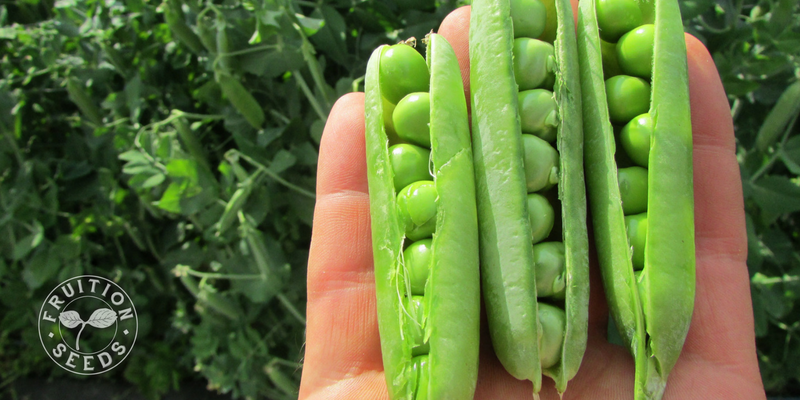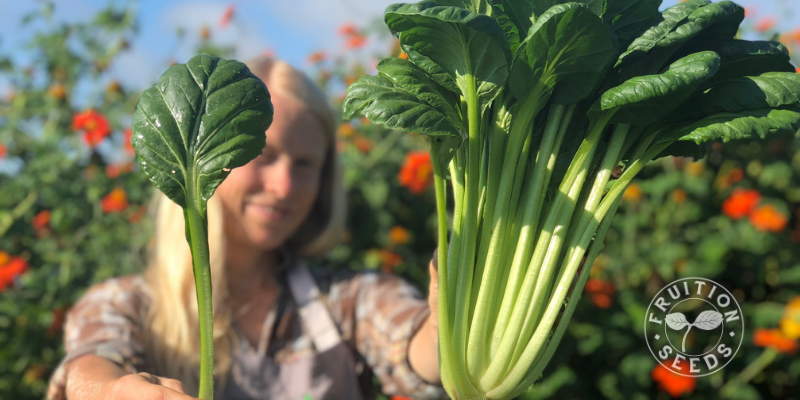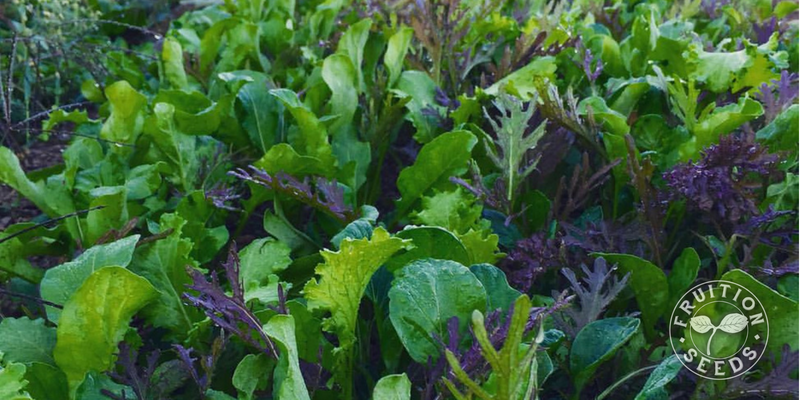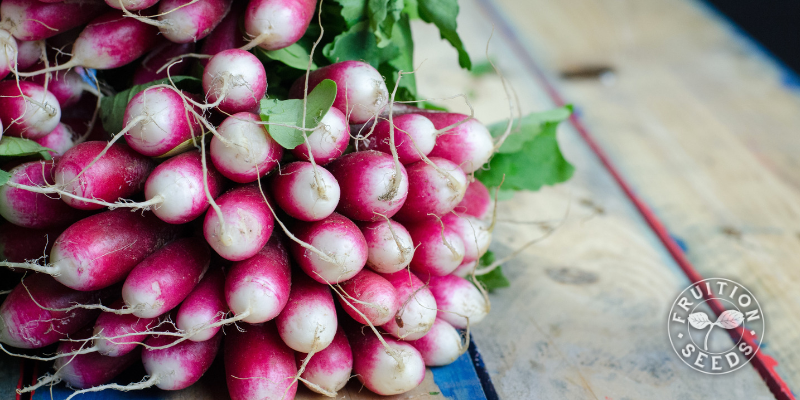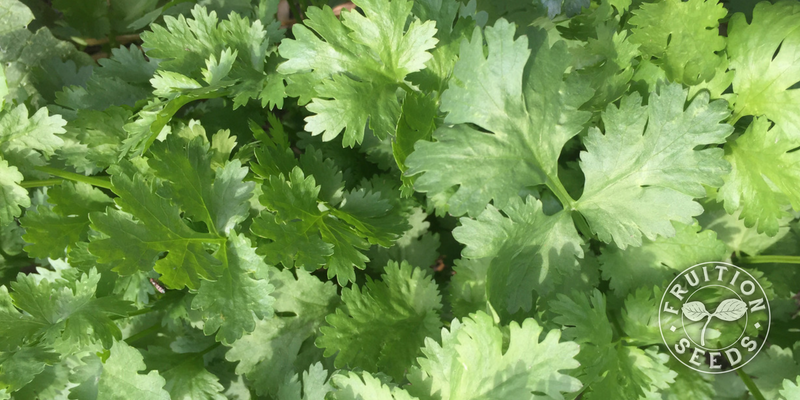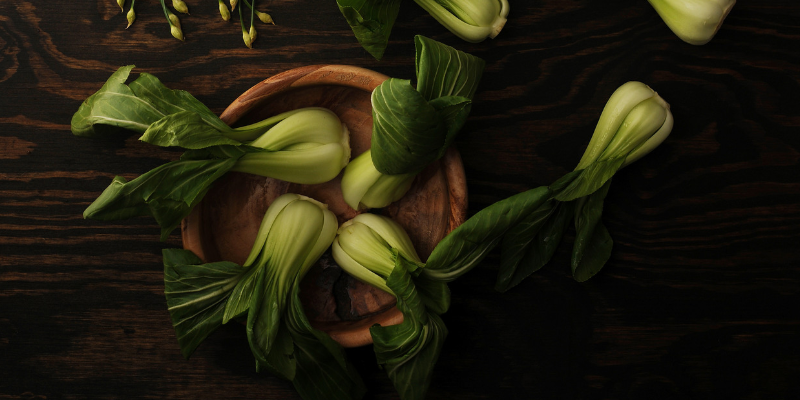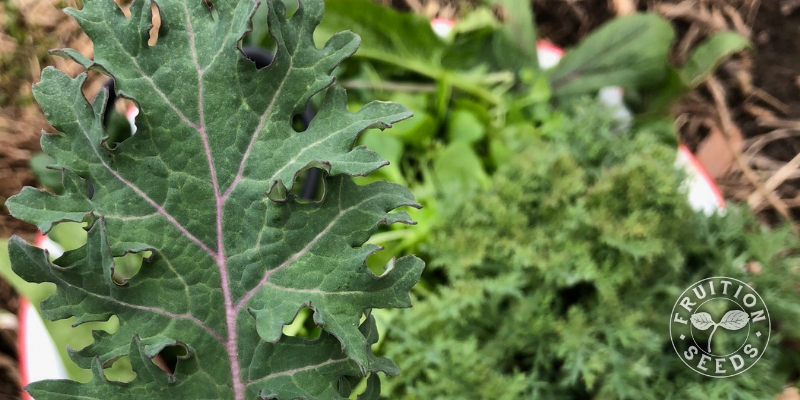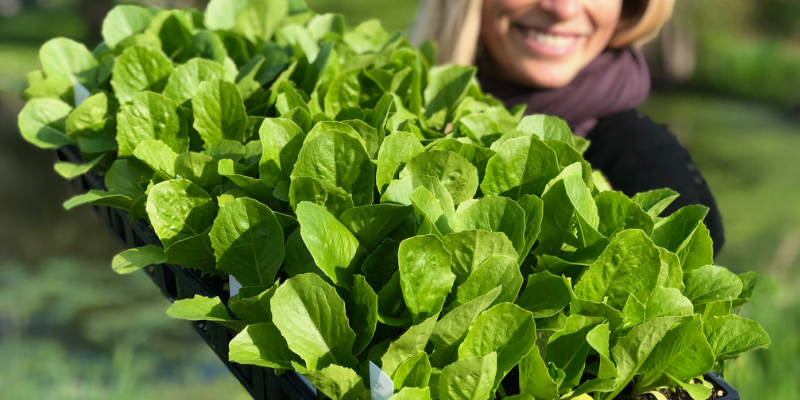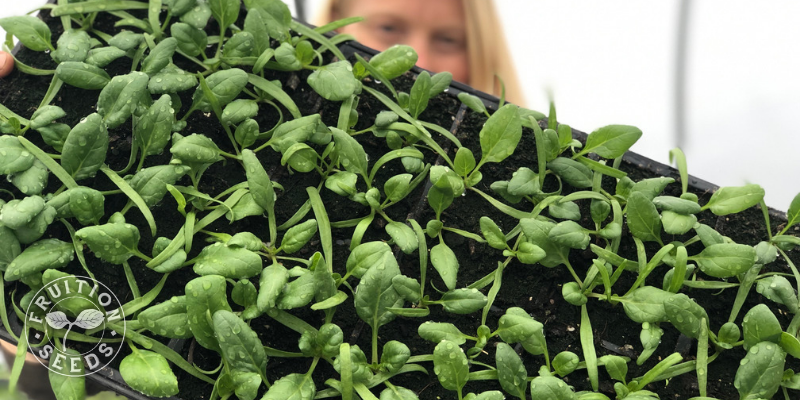As robins flock, days warm and daffodils rise, our psyches itch to sow seeds. That first delicious day in the 60s sends the shoes off my feet as I scramble to plant peas, spinach cilantro and those first, sweet radishes of the season. Truly, there are few finer feelings.
So Friends, I’m excited to share what I’m sowing directly in the ground ~6 weeks before final frost here in the Finger Lakes, Zone 5!
But first, two things about soil temperature and texture, everyone’s favorite subject:
Before You Sow Seeds in the Soil This Spring
…let’s talk Texture
If your soil is soupy, even a little, your seeds will likely rot. We typically direct sow and transplant into our raised beds and containers, which warm up and drain much more quickly than the garden soil, between two or three weeks before we plant into our gardens. Even light tillage of wet soils will compact and destroy your soil texture, sometimes taking years to recover.
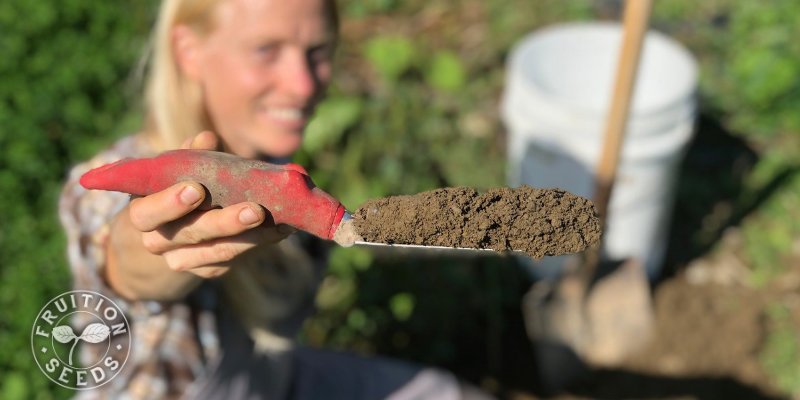
How do you know if your soil is well-drained enough to till, to sow? With a shovel, dig six inches into the soil. From the bottom of your hole, lift a small handful of soil and make a ball, dropping it to the ground from waist-height. If your ball sticks together, your soil is not yet ready to be worked. If your ball breaks apart into a thousand crumbles, all systems go!
…now Temperature
All seeds will germinate within a range of temperatures, some wider than others.
Peas, for example, will germinate in soils as low as 40 F, though they germinate best between 50 and 75 F. Their optimal temperature to germinate fastest is 75 F. In 40 F soils, your peas may take 2 to 3 weeks to germinate. At 75 F, your peas will have the highest germination rate and are often racing skyward in 4 or 5 days. Each crop, like each of us, has its own unique and sometimes specific preferences.
…and of Seeds and Weeds
Keep in mind, as you sow seeds directly in the soil, that weed seeds are germinating at that precise moment as well. Yes, you can technically sow some seeds insanely early ie, they’ll survive cold, wet soils better than most. I’ve found that resisting that urge to sow as early as possible has resulted in higher, quicker germination rates and notably reduced weeding. Let other people proclaim, “I’ve already planted my peas, have you?” and know that each day and each degree of soils warming will make your peas sprout all the sooner and indeed, truly thrive rather than simply survive.
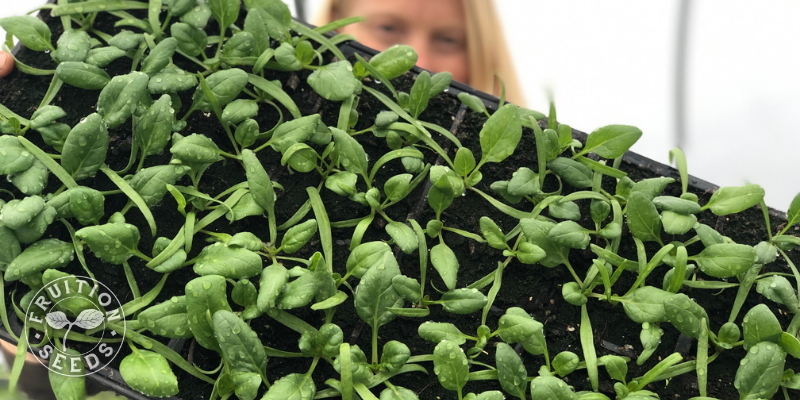
Okay, I know, you’re ready to sow seeds and so am I! Without further ado…
Here are the seeds we direct sow about 6 weeks before final frost…
Peas
Germination Temperature: Peas are exceptionally tolerant of cool soils, germinating in soils as low as 40 F, though they germinate best between 50 and 75 F. Their optimal temperature to germinate fastest is 75 F. In 40 F soils, your peas may take 2 to 3 weeks to germinate. At 75 F, your peas will have the highest germination rate and are often racing skyward in 4 or 5 days.
When to Sow: Depending on soil texture, we sow peas between early April and mid-May. After mid-May, we find the summer heat reduces the tenderness and the sugars of pea pods. Our mid-August-sown dwarf peas, maturing into the cool of autumn, are the sweetest and most tender.
Direct Sow Only: Peas quite despise being transplanted, so please resist all temptation. If you absolutely must, you’re best bet is to sow them in 2-inch soil blocks and transplant them as soon as they sprout.
Spinach
Germination Temperature: Spinach is also exceptionally tolerant of cool soils, germinating in soils as low as 35 F, though they germinate best between 45 and 65 F. We sow in September, covering her with row cover for the winter and harvest her sweet, tender greens in fall, warm winter Spinach seed will not germinate in soils above 85 F. Asian Spinach has similar germination preferences in the cold, though she doesn’t hesitate to leap out of the soil all season long, even in the heat of summer.
When to Sow: Depending on soil texture, we sow spinach between early April and early May, right alongside peas. Spinach bolts quickly with the suggestion of summer heat, so spinach sown after Memorial Day generally doesn’t germinate well. Those seeds that do germinate will bolt quickly, going to seed before you’ve had much of a salad. Asian spinach, one of my favorite greens of all time, is equally cold-tolerant, surviving the winter when fall-sown, though she’s also heat-tolerant, so we enjoy her in salads and quiches as a classic spinach substitute in the heat of summer.
Direct Sow or Transplant: Both classic and Asian spinach is equally resilient when direct sown or transplanted. We generally transplant them, just to save the additional weeding, but if growing glorious transplants is at all a challenge, keep life simple and direct-sow.
Winter Green Mesclun Mix
Germination Temperature: Mesclun mix contains a diversity of species, making her germination temperature(s) less precise, but our Winter Green Mesclun exceptionally resilient. Since she’s selected to germinate and re-grow quickly in cold temperatures, we always sow her with spinach in the fall or peas in the spring.
When to Sow: Most mesclun mixes will thrive sown in mid-May here in Zone 5, but our Winter Green Mesclun has been specifically selected to re-grow quickly in cold temperatures. Sow her alongside your peas and you’ll be glad you did! Sow her in fall, harvesting through the winter and spring, and that is the dream.
Direct Sow Only: Mesclun mix is traditionally harvested as densely sown baby greens, best direct sown.
Arugula
Germination Temperature: Arugula thrives in a wide window of soil temperatures, including soils as cool as 40 F and warm as 80 F, though its highest and quickest germination is between 45 and 55 F.
When to Sow: Depending on soil texture, we sow arugula between early April and mid-May. Cooler soil temperatures grow less spicy, more tender leaves that bolt less quickly. Arugula can be sown in summer, just be sure to keep it well-watered and if it can grow in the shade of say, a sunflower, she’ll bolt less quickly. Flea beetles will ravage arugula (and anything else in the brassica family) in spring and early summer, but only if you don’t lay floating row cover over her.
Direct Sow or Transplant: Arugula thrives equally when direct sown or transplanted. We generally transplant them, just to save the additional weeding, but if tending transplants is at all a challenge, keep life simple and direct-sow.
Radish
Germination Temperature: Radishes are also exceptionally tolerant of early spring soils, germinating in temperatures as low as 40 F. Optimum radish germination range is 55 to 85 F. Fun Fact: the spicy heat of some radishes is caused by stress. What makes a radish stressed? Too little water, too much heat and/or too few nutrients. So yes: radish spice is a choose-your-own-adventure in your garden!
When to Sow: Planting radishes are another harbinger of spring! Depending on soil texture, we sow our first radishes between early and late April. After mid-May, we only sow radishes in the shade of larger plants (tomatoes, lettuce) and to mark the rows of carrots, as well.
Direct Sow Only: Radishes (and indeed all root crops) strongly prefer being direct-sown.
Friends! Watermelon radish is entirely different, a fall radish only, so don’t be tempted to sow her until early/mid-August when she can mature her sweet, succulent root as summer heat subsides.
Cilantro
Germination Temperature: Cilantro, who knew?! I grew up associating cilantro with salsa and the height of summer, but turns out she loves to grow in the cold. Though her optimum germination temperature is 55 to 68 F, she will germinate at 45 F and if the snow falls, she won’t blink.
When to Sow: Depending on soil texture, we sow cilantro alongside our peas as early as we can, often in April. Our September-sown cilantro we harvest once or twice before snowfall and she often overwinters, even uncovered in our fields, quickly re-growing once the snows melt. If you’re sowing cilantro in the summer, plant it in the partial shade (of a tomato or pole beans, for example) to prolong it’s leaf production before she goes to seed.
Direct Sow Only: Another secret to growing cilantro: she hates being transplanted. Part of the reason cilantro bolts so quickly is that she’s stressed. The three main things that stress cilantro are too much heat, too little water and being transplanted.
Pac Choy
Germination Temperature: Pac choy, similar to arugula and other brassicas, thrive in a wide window of soil temperatures, including soils as cool as 40 F and warm as 80 F. Their highest and quickest germination is between 45 and 55 F. Bok choi and any other ‘choi,’ including chinese cabbage, follows suit.
When to Sow: Depending on soil texture, we sow pac choy as early as the beginning of April, though sometimes it’s early May before the soil is ready to be sown. Pac choy can be sown in summer, just be sure to keep it well-watered and if it can grow in the shade of say, your pole beans, she’ll bolt less quickly. Flea beetles will ravage pac choy (and anything else in the brassica family) in spring and early summer, so spread floating row cover over her to exclude those pesky insects.
Direct Sow or Transplant: Pac choy thrives equally when direct sown or transplanted. We generally transplant them, just to save the additional weeding, but if tending transplants is at all a challenge, keep life simple and direct-sow them.
Red Russian Kale
Germination Temperature: Kale, like other brassicas, thrive in a wide window of soil temperatures, including soils as cool as 40 F and warm as 80 F. Their highest and quickest germination is between 68 and 80 F. The Russian- or Siberian-style varieties are the most cold-hardy. Our Red Russian, for example, overwinters uncovered in the field when sown in September and her vigorous spring re-growth is so sweet, as soon as the snows melt. Bear Necessities is also impressively cold-hardy, even among kales.
When to Sow: Depending on soil texture, we sow kale as early as the beginning of April though sometimes it’s early May before the soil is ready to be sown. Flea beetles will riddle your kale (and anything else in the brassica family) with holes in spring and early summer, so spread floating row cover over her to exclude them.
Direct Sow or Transplant: Kale, direct sown or transplanted, will thrive. We generally transplant them, just to save the additional weeding, but if tending transplants is at all a challenge, keep life simple and direct-sow them. If you’re transplanting them, know their ideal temperature is about 60 F as seedlings.
Cold-Hardy Lettuce
Germination Temperature: Not all lettuces thrive in the cold, but those that do are remarkably resilient. Varieties like Winter Density and Flashy Trout Back romaine will germinate as low as 40 F, though their optimal germination temperature is 70 to 80 F, along with the lettuces that prefer to grow in the heat of summer.
When to Sow: We sow cold-hardy lettuces along with our first sown peas anywhere between early April and mid-May, depending on soil texture. Heat-tolerant lettuces we sow starting mid-May and we start sowing cold-hardy lettuces once more in September.
Direct Sow or Transplant: Lettuce, direct sown or transplanted, will thrive. We generally transplant them, just to save the additional weeding, but if tending transplants is at all a challenge, keep life simple and direct-sow them.
People often herald Memorial Day as the beginning of gardening season here in Zone 5 and Friends, if you sow the right seeds in soil once it’s ready, you’ll be eating for weeks if not months prior!
Keep pushing the envelope and share what you learn, we’re all in this together!
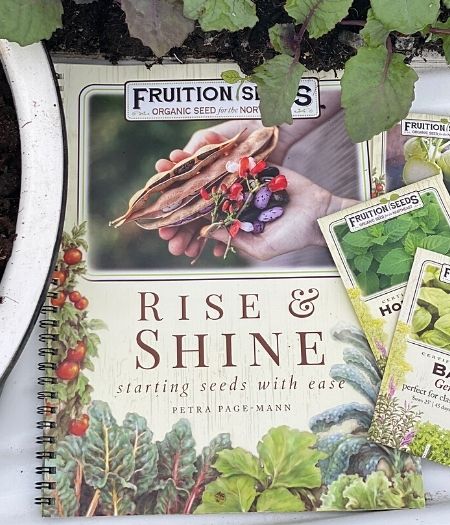
enjoy Fruition's free online
Growing Library!
Enjoy all Fruition's growing resources including:
~ growing guides ~
~ ebooks ~
~ planting charts ~
~ infographics ~
All in one place, viewable and download-able anytime...
~When you join us, check your inbox for your welcome & access info! Stay tuned for our weekly organic gardening tips & inspiration, as well~

